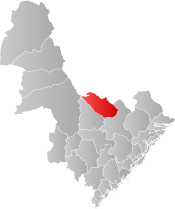Gjøvdal
Gjøvdal herred
Gjevedal herred (historic) | |
|---|---|
 View of the local Gjøvdal Church | |
 Gjøvdal within Aust-Agder | |
| Coordinates: 58°52′18″N 08°18′14″E / 58.87167°N 8.30389°ECoordinates: 58°52′18″N 08°18′14″E / 58.87167°N 8.30389°E | |
| Country | Norway |
| County | Aust-Agder |
| District | Østre Agder |
| Established | 1 Jan 1908 |
| • Preceded by | Åmli Municipality |
| Disestablished | 1 Jan 1960 |
| • Succeeded by | Åmli Municipality |
| Administrative centre | Askland |
| Population (1960) | |
| • Total | 362 |
| Time zone | UTC+01:00 (CET) |
| • Summer (DST) | UTC+02:00 (CEST) |
| ISO 3166 code | NO-0930 |
Gjøvdal (historic: Gjevedal) is a former municipality in the old Aust-Agder county in Norway. The municipality existed from 1908 until its dissolution in 1960. It covered the Gjøv river valley and the surrounding moors. It is currently part of the municipality of Åmli in Agder county. The administrative centre was the village of Askland where Gjøvdal Church is located.[2]
History
The parish of Gjøvdal was part of the municipality of Åmli since 1 January 1838 (see formannskapsdistrikt law). On 1 January 1908, the municipality of Åmli was split into three separate municipalities: Gjevedal (population: 590), Lille Topdal (population: 389), and Åmli (population: 2,024). In 1911, the name Gjevedal was changed to "Gjøvdal".
During the 1960s, there were many municipal mergers across Norway due to the work of the Schei Committee. On 1 January 1960, the municipality of Gjøvdal (population: 362) was reunited with Åmli (population: 1,947) to form a new, enlarged Åmli municipality. (The municipality of Tovdal was merged into Åmli in 1967.)[3][4]
Name
The municipality (originally the parish) is named after the Gjevedal valley (Old Norse: Gefardalr). The first element is the name of the river Gjøv (Gef) which flows through the valley. Gef means "to give (as in a reward to the fisherman)". The last element is dalr which means "valley" or "dale".[5]
Government
All municipalities in Norway, including Gjøvdal, are responsible for primary education (through 10th grade), outpatient health services, senior citizen services, unemployment and other social services, zoning, economic development, and municipal roads. The municipality was governed by a municipal council of elected representatives, which in turn elected a mayor.[6]
Municipal council
The municipal council (Herredsstyre) of Gjøvdal was made up of 13 representatives that were elected to four year terms. The party breakdown of the final municipal council was as follows:
| Party Name (in Norwegian) | Number of representatives | |
|---|---|---|
| Labour Party (Arbeiderpartiet) | 9 | |
| Farmers' Party (Bondepartiet) | 4 | |
| Total number of members: | 13 | |
| Party Name (in Norwegian) | Number of representatives | |
|---|---|---|
| Labour Party (Arbeiderpartiet) | 7 | |
| Joint List(s) of Non-Socialist Parties (Borgerlige Felleslister) | 5 | |
| Total number of members: | 12 | |
| Party Name (in Norwegian) | Number of representatives | |
|---|---|---|
| Labour Party (Arbeiderpartiet) | 7 | |
| Joint List(s) of Non-Socialist Parties (Borgerlige Felleslister) | 5 | |
| Total number of members: | 12 | |
| Party Name (in Norwegian) | Number of representatives | |
|---|---|---|
| Labour Party (Arbeiderpartiet) | 7 | |
| Joint List(s) of Non-Socialist Parties (Borgerlige Felleslister) | 5 | |
| Total number of members: | 12 | |
| Party Name (in Norwegian) | Number of representatives | |
|---|---|---|
| Labour Party (Arbeiderpartiet) | 7 | |
| Joint list of the Farmers' Party (Bondepartiet) and the Liberal Party (Venstre) | 5 | |
| Total number of members: | 12 | |
| Note: Due to the German occupation of Norway during World War II, no elections were held for new municipal councils until after the war ended in 1945. | ||
See also
References
- ^ "Forskrift om målvedtak i kommunar og fylkeskommunar" (in Norwegian). Lovdata.no.
- ^ Thorsnæs, Geir, ed. (20 June 2015). "Gjøvdal". Store norske leksikon (in Norwegian). Kunnskapsforlaget. Retrieved 18 December 2017.
- ^ Jukvam, Dag (1999). "Historisk oversikt over endringer i kommune- og fylkesinndelingen" (PDF) (in Norwegian). Statistisk sentralbyrå.
- ^ "Gjøvdal". Store Norske Leksikon (in Norwegian). Retrieved 10 March 2009.
- ^ Rygh, Oluf (1905). Norske gaardnavne: Nedenes amt (in Norwegian) (8 ed.). Kristiania, Norge: W. C. Fabritius & sønners bogtrikkeri. p. 54.
- ^ Hansen, Tore, ed. (12 May 2016). "kommunestyre". Store norske leksikon (in Norwegian). Kunnskapsforlaget. Retrieved 21 December 2020.
- ^ "Kommunevalgene og Ordførervalgene 1955" (PDF) (in Norwegian). Oslo: Statistisk sentralbyrå. 1957. Retrieved 21 December 2020.
- ^ "Kommunevalgene og Ordførervalgene 1951" (PDF) (in Norwegian). Oslo: Statistisk sentralbyrå. 1952. Retrieved 21 December 2020.
- ^ "Kommunevalgene og Ordførervalgene 1947" (PDF) (in Norwegian). Oslo: Statistisk sentralbyrå. 1948. Retrieved 21 December 2020.
- ^ "Kommunevalgene og Ordførervalgene 1945" (PDF) (in Norwegian). Oslo: Statistisk sentralbyrå. 1947. Retrieved 21 December 2020.
- ^ "Kommunevalgene og Ordførervalgene 1937" (PDF) (in Norwegian). Oslo: Statistisk sentralbyrå. 1938. Retrieved 21 December 2020.
External links
 Aust-Agder travel guide from Wikivoyage
Aust-Agder travel guide from Wikivoyage
- CS1 Norwegian-language sources (no)
- Articles with short description
- Short description with empty Wikidata description
- Coordinates not on Wikidata
- Articles containing Old Norse-language text
- Articles containing Norwegian-language text
- Articles containing Bokmål-language text
- AC with 0 elements
- Use dmy dates from December 2020
- Åmli
- Former municipalities of Norway
- 1908 establishments in Norway
- 1960 disestablishments in Norway


